Analyzing Management Functions: Business Success and Talent Strategies
VerifiedAdded on 2023/06/15
|11
|1931
|411
Report
AI Summary
This report provides an overview of management functions and their impact on business success. It discusses different organizational structures, including flat and tall structures, and their advantages and disadvantages. The report also examines the marketing function and its role in creating product awareness and driving sales. Furthermore, it delves into talent management, highlighting the role of HR in recruiting and performance management, and explores how a positive organizational culture can impact employee satisfaction and team dynamics. The report concludes that effective management is essential for maintaining employee discipline and optimizing human resources to achieve organizational goals. Desklib provides access to similar solved assignments and resources for students.
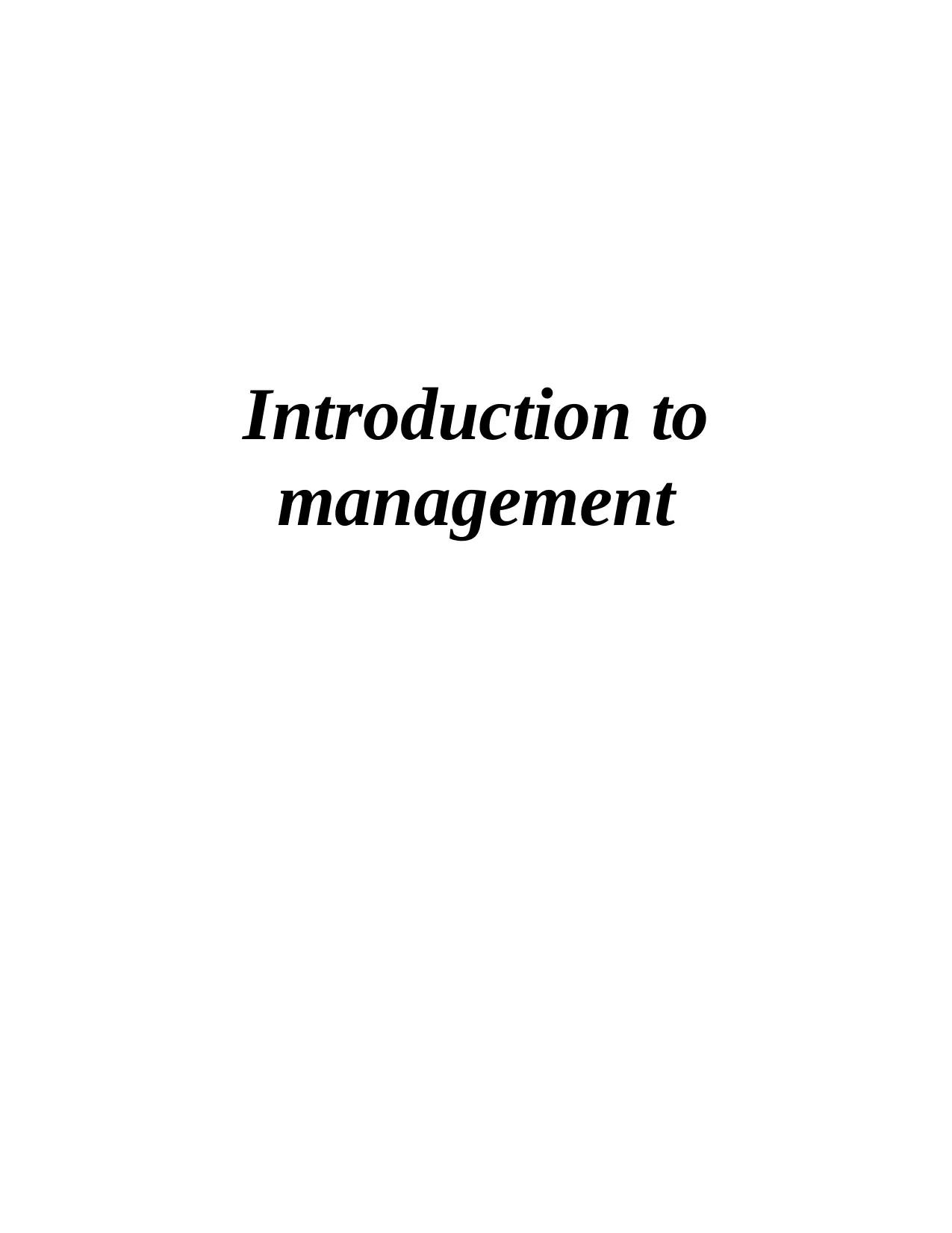
Introduction to
management
management
Paraphrase This Document
Need a fresh take? Get an instant paraphrase of this document with our AI Paraphraser
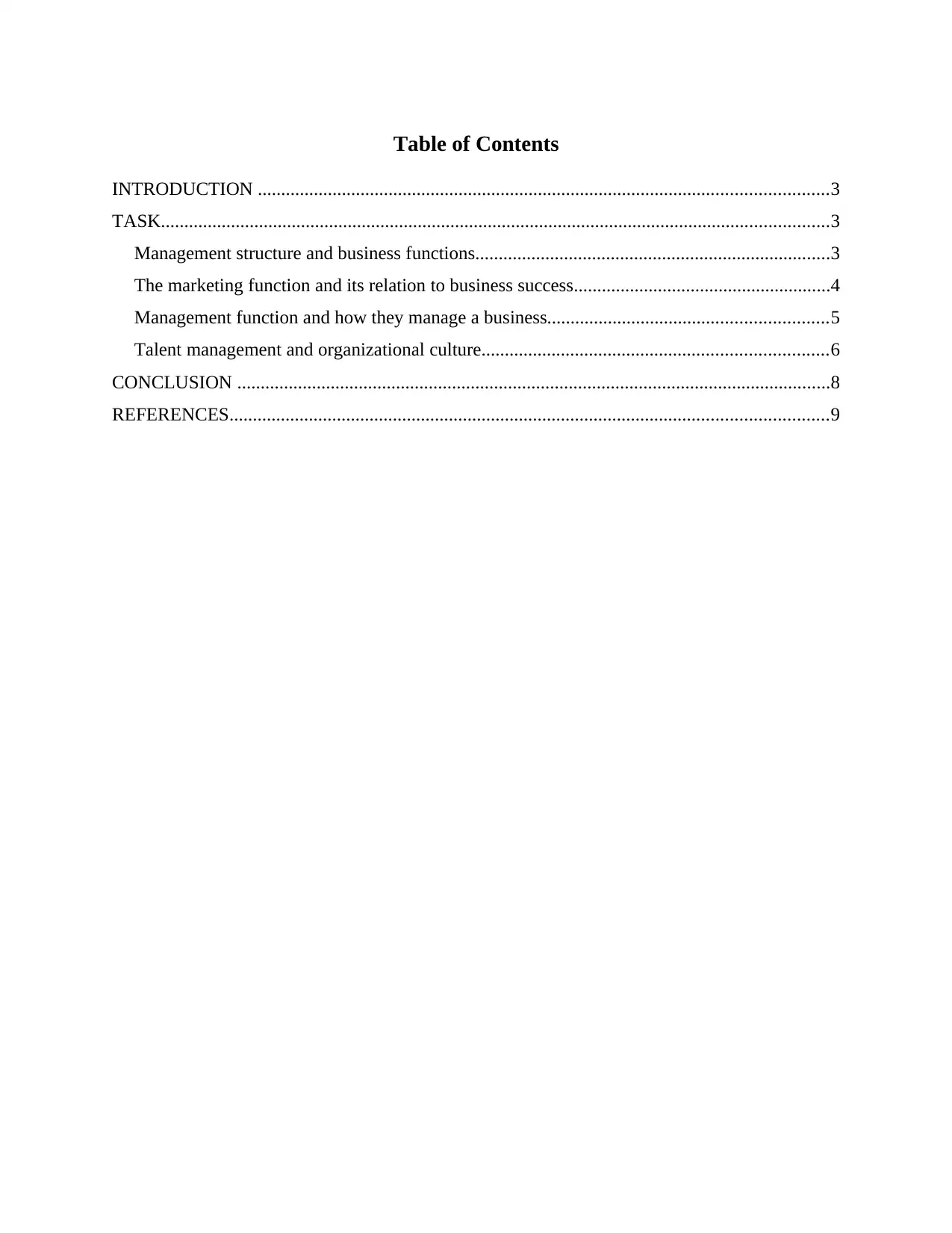
Table of Contents
INTRODUCTION ..........................................................................................................................3
TASK...............................................................................................................................................3
Management structure and business functions............................................................................3
The marketing function and its relation to business success.......................................................4
Management function and how they manage a business............................................................5
Talent management and organizational culture..........................................................................6
CONCLUSION ...............................................................................................................................8
REFERENCES................................................................................................................................9
INTRODUCTION ..........................................................................................................................3
TASK...............................................................................................................................................3
Management structure and business functions............................................................................3
The marketing function and its relation to business success.......................................................4
Management function and how they manage a business............................................................5
Talent management and organizational culture..........................................................................6
CONCLUSION ...............................................................................................................................8
REFERENCES................................................................................................................................9
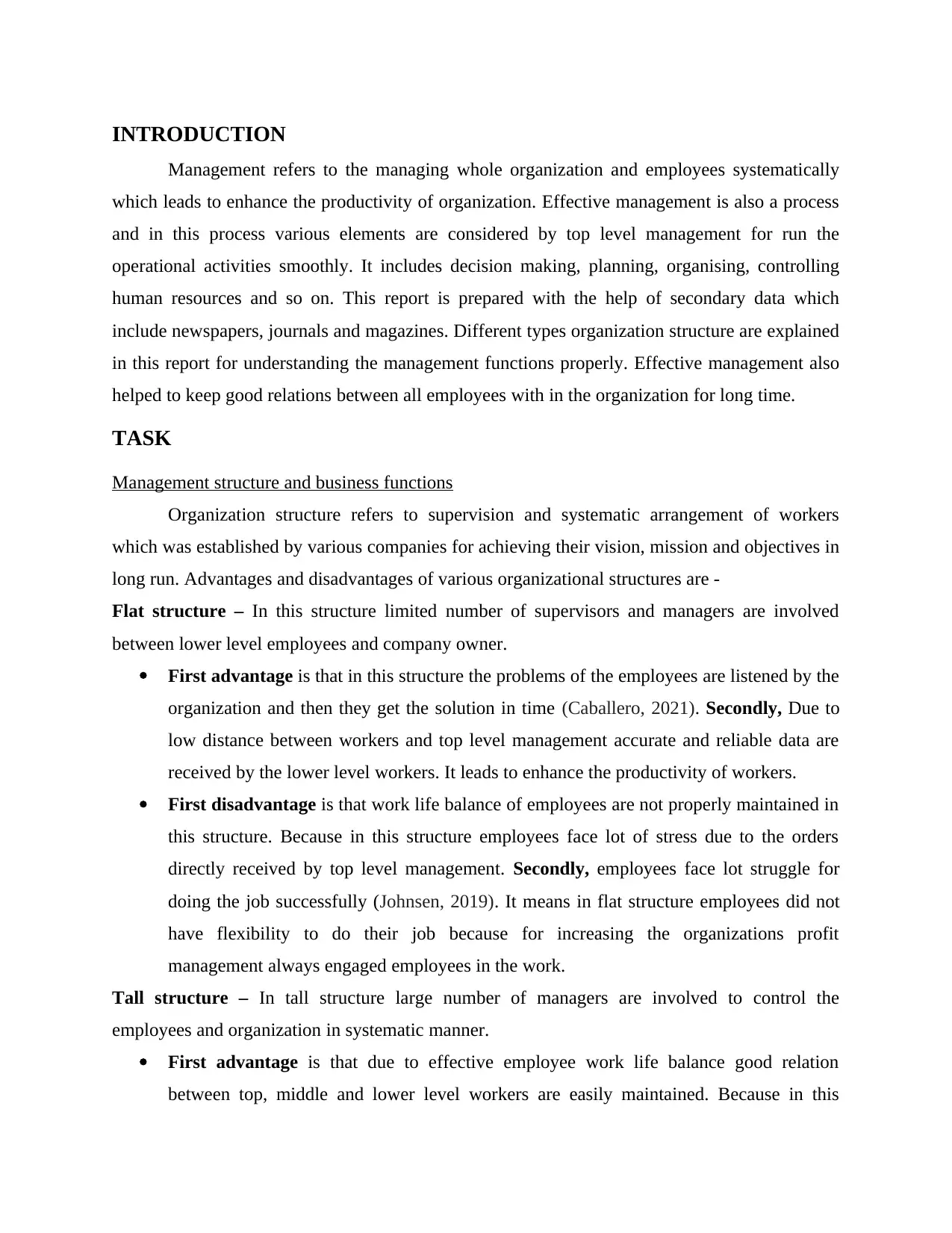
INTRODUCTION
Management refers to the managing whole organization and employees systematically
which leads to enhance the productivity of organization. Effective management is also a process
and in this process various elements are considered by top level management for run the
operational activities smoothly. It includes decision making, planning, organising, controlling
human resources and so on. This report is prepared with the help of secondary data which
include newspapers, journals and magazines. Different types organization structure are explained
in this report for understanding the management functions properly. Effective management also
helped to keep good relations between all employees with in the organization for long time.
TASK
Management structure and business functions
Organization structure refers to supervision and systematic arrangement of workers
which was established by various companies for achieving their vision, mission and objectives in
long run. Advantages and disadvantages of various organizational structures are -
Flat structure – In this structure limited number of supervisors and managers are involved
between lower level employees and company owner.
First advantage is that in this structure the problems of the employees are listened by the
organization and then they get the solution in time (Caballero, 2021). Secondly, Due to
low distance between workers and top level management accurate and reliable data are
received by the lower level workers. It leads to enhance the productivity of workers.
First disadvantage is that work life balance of employees are not properly maintained in
this structure. Because in this structure employees face lot of stress due to the orders
directly received by top level management. Secondly, employees face lot struggle for
doing the job successfully (Johnsen, 2019). It means in flat structure employees did not
have flexibility to do their job because for increasing the organizations profit
management always engaged employees in the work.
Tall structure – In tall structure large number of managers are involved to control the
employees and organization in systematic manner.
First advantage is that due to effective employee work life balance good relation
between top, middle and lower level workers are easily maintained. Because in this
Management refers to the managing whole organization and employees systematically
which leads to enhance the productivity of organization. Effective management is also a process
and in this process various elements are considered by top level management for run the
operational activities smoothly. It includes decision making, planning, organising, controlling
human resources and so on. This report is prepared with the help of secondary data which
include newspapers, journals and magazines. Different types organization structure are explained
in this report for understanding the management functions properly. Effective management also
helped to keep good relations between all employees with in the organization for long time.
TASK
Management structure and business functions
Organization structure refers to supervision and systematic arrangement of workers
which was established by various companies for achieving their vision, mission and objectives in
long run. Advantages and disadvantages of various organizational structures are -
Flat structure – In this structure limited number of supervisors and managers are involved
between lower level employees and company owner.
First advantage is that in this structure the problems of the employees are listened by the
organization and then they get the solution in time (Caballero, 2021). Secondly, Due to
low distance between workers and top level management accurate and reliable data are
received by the lower level workers. It leads to enhance the productivity of workers.
First disadvantage is that work life balance of employees are not properly maintained in
this structure. Because in this structure employees face lot of stress due to the orders
directly received by top level management. Secondly, employees face lot struggle for
doing the job successfully (Johnsen, 2019). It means in flat structure employees did not
have flexibility to do their job because for increasing the organizations profit
management always engaged employees in the work.
Tall structure – In tall structure large number of managers are involved to control the
employees and organization in systematic manner.
First advantage is that due to effective employee work life balance good relation
between top, middle and lower level workers are easily maintained. Because in this
⊘ This is a preview!⊘
Do you want full access?
Subscribe today to unlock all pages.

Trusted by 1+ million students worldwide
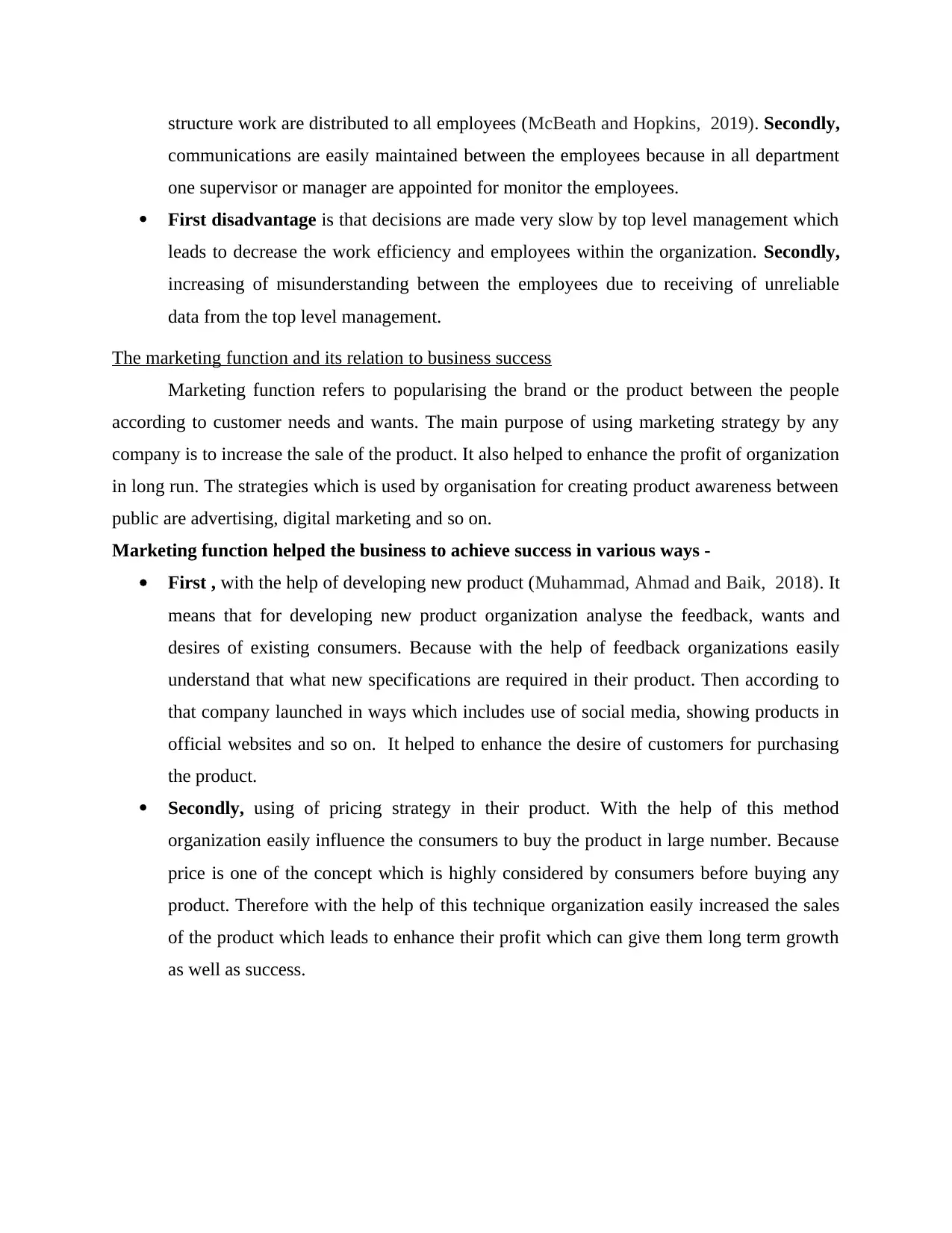
structure work are distributed to all employees (McBeath and Hopkins, 2019). Secondly,
communications are easily maintained between the employees because in all department
one supervisor or manager are appointed for monitor the employees.
First disadvantage is that decisions are made very slow by top level management which
leads to decrease the work efficiency and employees within the organization. Secondly,
increasing of misunderstanding between the employees due to receiving of unreliable
data from the top level management.
The marketing function and its relation to business success
Marketing function refers to popularising the brand or the product between the people
according to customer needs and wants. The main purpose of using marketing strategy by any
company is to increase the sale of the product. It also helped to enhance the profit of organization
in long run. The strategies which is used by organisation for creating product awareness between
public are advertising, digital marketing and so on.
Marketing function helped the business to achieve success in various ways -
First , with the help of developing new product (Muhammad, Ahmad and Baik, 2018). It
means that for developing new product organization analyse the feedback, wants and
desires of existing consumers. Because with the help of feedback organizations easily
understand that what new specifications are required in their product. Then according to
that company launched in ways which includes use of social media, showing products in
official websites and so on. It helped to enhance the desire of customers for purchasing
the product.
Secondly, using of pricing strategy in their product. With the help of this method
organization easily influence the consumers to buy the product in large number. Because
price is one of the concept which is highly considered by consumers before buying any
product. Therefore with the help of this technique organization easily increased the sales
of the product which leads to enhance their profit which can give them long term growth
as well as success.
communications are easily maintained between the employees because in all department
one supervisor or manager are appointed for monitor the employees.
First disadvantage is that decisions are made very slow by top level management which
leads to decrease the work efficiency and employees within the organization. Secondly,
increasing of misunderstanding between the employees due to receiving of unreliable
data from the top level management.
The marketing function and its relation to business success
Marketing function refers to popularising the brand or the product between the people
according to customer needs and wants. The main purpose of using marketing strategy by any
company is to increase the sale of the product. It also helped to enhance the profit of organization
in long run. The strategies which is used by organisation for creating product awareness between
public are advertising, digital marketing and so on.
Marketing function helped the business to achieve success in various ways -
First , with the help of developing new product (Muhammad, Ahmad and Baik, 2018). It
means that for developing new product organization analyse the feedback, wants and
desires of existing consumers. Because with the help of feedback organizations easily
understand that what new specifications are required in their product. Then according to
that company launched in ways which includes use of social media, showing products in
official websites and so on. It helped to enhance the desire of customers for purchasing
the product.
Secondly, using of pricing strategy in their product. With the help of this method
organization easily influence the consumers to buy the product in large number. Because
price is one of the concept which is highly considered by consumers before buying any
product. Therefore with the help of this technique organization easily increased the sales
of the product which leads to enhance their profit which can give them long term growth
as well as success.
Paraphrase This Document
Need a fresh take? Get an instant paraphrase of this document with our AI Paraphraser
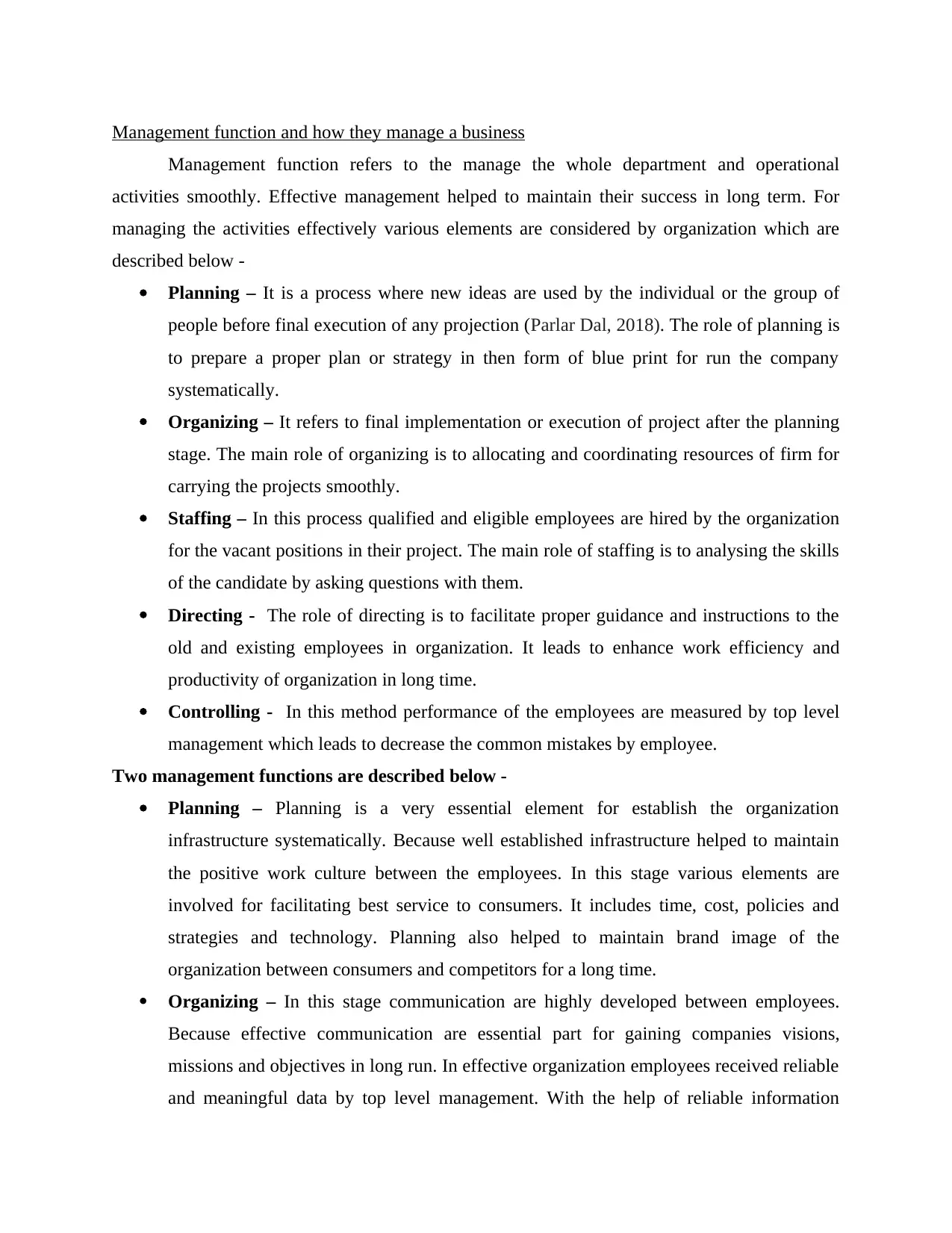
Management function and how they manage a business
Management function refers to the manage the whole department and operational
activities smoothly. Effective management helped to maintain their success in long term. For
managing the activities effectively various elements are considered by organization which are
described below -
Planning – It is a process where new ideas are used by the individual or the group of
people before final execution of any projection (Parlar Dal, 2018). The role of planning is
to prepare a proper plan or strategy in then form of blue print for run the company
systematically.
Organizing – It refers to final implementation or execution of project after the planning
stage. The main role of organizing is to allocating and coordinating resources of firm for
carrying the projects smoothly.
Staffing – In this process qualified and eligible employees are hired by the organization
for the vacant positions in their project. The main role of staffing is to analysing the skills
of the candidate by asking questions with them.
Directing - The role of directing is to facilitate proper guidance and instructions to the
old and existing employees in organization. It leads to enhance work efficiency and
productivity of organization in long time.
Controlling - In this method performance of the employees are measured by top level
management which leads to decrease the common mistakes by employee.
Two management functions are described below -
Planning – Planning is a very essential element for establish the organization
infrastructure systematically. Because well established infrastructure helped to maintain
the positive work culture between the employees. In this stage various elements are
involved for facilitating best service to consumers. It includes time, cost, policies and
strategies and technology. Planning also helped to maintain brand image of the
organization between consumers and competitors for a long time.
Organizing – In this stage communication are highly developed between employees.
Because effective communication are essential part for gaining companies visions,
missions and objectives in long run. In effective organization employees received reliable
and meaningful data by top level management. With the help of reliable information
Management function refers to the manage the whole department and operational
activities smoothly. Effective management helped to maintain their success in long term. For
managing the activities effectively various elements are considered by organization which are
described below -
Planning – It is a process where new ideas are used by the individual or the group of
people before final execution of any projection (Parlar Dal, 2018). The role of planning is
to prepare a proper plan or strategy in then form of blue print for run the company
systematically.
Organizing – It refers to final implementation or execution of project after the planning
stage. The main role of organizing is to allocating and coordinating resources of firm for
carrying the projects smoothly.
Staffing – In this process qualified and eligible employees are hired by the organization
for the vacant positions in their project. The main role of staffing is to analysing the skills
of the candidate by asking questions with them.
Directing - The role of directing is to facilitate proper guidance and instructions to the
old and existing employees in organization. It leads to enhance work efficiency and
productivity of organization in long time.
Controlling - In this method performance of the employees are measured by top level
management which leads to decrease the common mistakes by employee.
Two management functions are described below -
Planning – Planning is a very essential element for establish the organization
infrastructure systematically. Because well established infrastructure helped to maintain
the positive work culture between the employees. In this stage various elements are
involved for facilitating best service to consumers. It includes time, cost, policies and
strategies and technology. Planning also helped to maintain brand image of the
organization between consumers and competitors for a long time.
Organizing – In this stage communication are highly developed between employees.
Because effective communication are essential part for gaining companies visions,
missions and objectives in long run. In effective organization employees received reliable
and meaningful data by top level management. With the help of reliable information
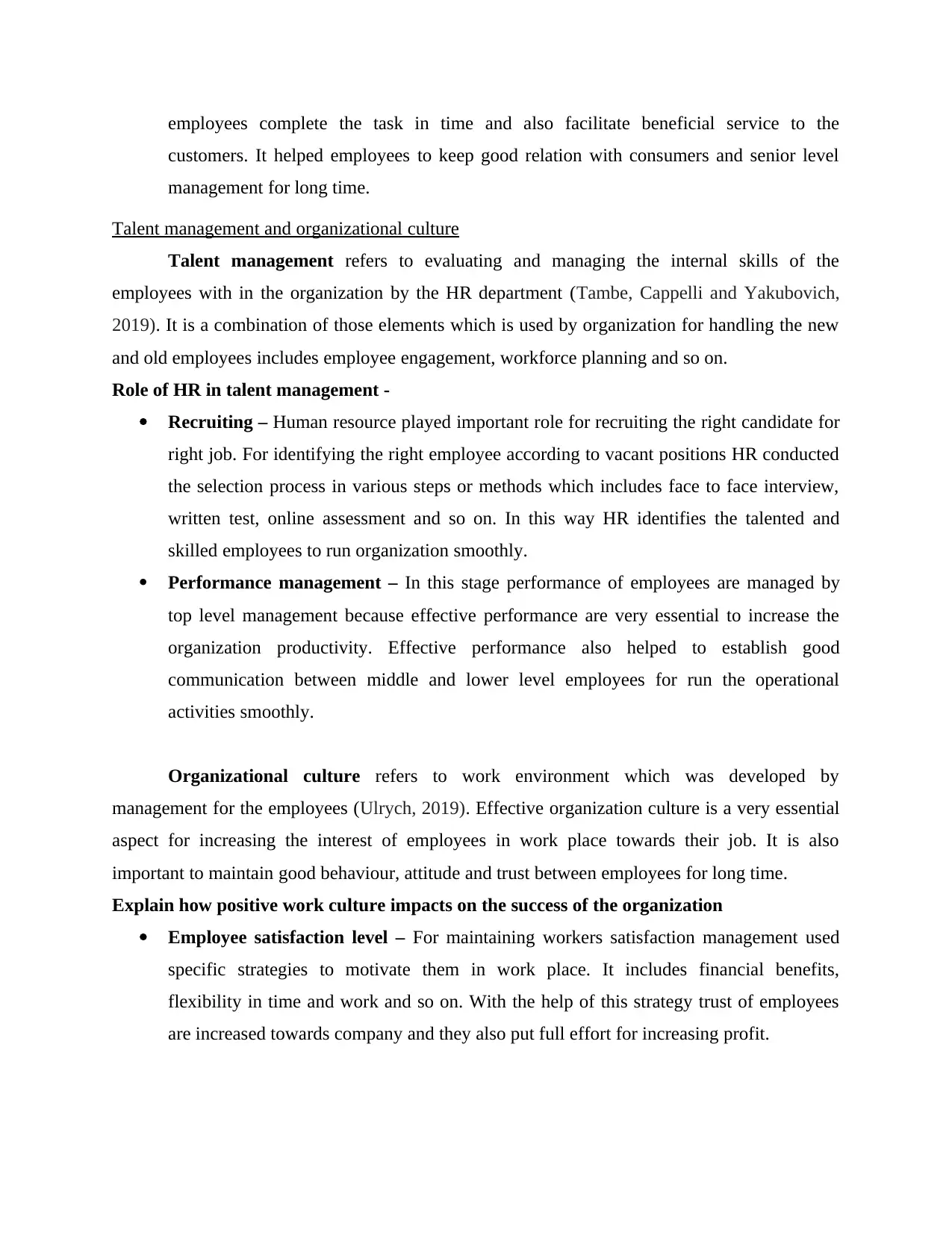
employees complete the task in time and also facilitate beneficial service to the
customers. It helped employees to keep good relation with consumers and senior level
management for long time.
Talent management and organizational culture
Talent management refers to evaluating and managing the internal skills of the
employees with in the organization by the HR department (Tambe, Cappelli and Yakubovich,
2019). It is a combination of those elements which is used by organization for handling the new
and old employees includes employee engagement, workforce planning and so on.
Role of HR in talent management -
Recruiting – Human resource played important role for recruiting the right candidate for
right job. For identifying the right employee according to vacant positions HR conducted
the selection process in various steps or methods which includes face to face interview,
written test, online assessment and so on. In this way HR identifies the talented and
skilled employees to run organization smoothly.
Performance management – In this stage performance of employees are managed by
top level management because effective performance are very essential to increase the
organization productivity. Effective performance also helped to establish good
communication between middle and lower level employees for run the operational
activities smoothly.
Organizational culture refers to work environment which was developed by
management for the employees (Ulrych, 2019). Effective organization culture is a very essential
aspect for increasing the interest of employees in work place towards their job. It is also
important to maintain good behaviour, attitude and trust between employees for long time.
Explain how positive work culture impacts on the success of the organization
Employee satisfaction level – For maintaining workers satisfaction management used
specific strategies to motivate them in work place. It includes financial benefits,
flexibility in time and work and so on. With the help of this strategy trust of employees
are increased towards company and they also put full effort for increasing profit.
customers. It helped employees to keep good relation with consumers and senior level
management for long time.
Talent management and organizational culture
Talent management refers to evaluating and managing the internal skills of the
employees with in the organization by the HR department (Tambe, Cappelli and Yakubovich,
2019). It is a combination of those elements which is used by organization for handling the new
and old employees includes employee engagement, workforce planning and so on.
Role of HR in talent management -
Recruiting – Human resource played important role for recruiting the right candidate for
right job. For identifying the right employee according to vacant positions HR conducted
the selection process in various steps or methods which includes face to face interview,
written test, online assessment and so on. In this way HR identifies the talented and
skilled employees to run organization smoothly.
Performance management – In this stage performance of employees are managed by
top level management because effective performance are very essential to increase the
organization productivity. Effective performance also helped to establish good
communication between middle and lower level employees for run the operational
activities smoothly.
Organizational culture refers to work environment which was developed by
management for the employees (Ulrych, 2019). Effective organization culture is a very essential
aspect for increasing the interest of employees in work place towards their job. It is also
important to maintain good behaviour, attitude and trust between employees for long time.
Explain how positive work culture impacts on the success of the organization
Employee satisfaction level – For maintaining workers satisfaction management used
specific strategies to motivate them in work place. It includes financial benefits,
flexibility in time and work and so on. With the help of this strategy trust of employees
are increased towards company and they also put full effort for increasing profit.
⊘ This is a preview!⊘
Do you want full access?
Subscribe today to unlock all pages.

Trusted by 1+ million students worldwide
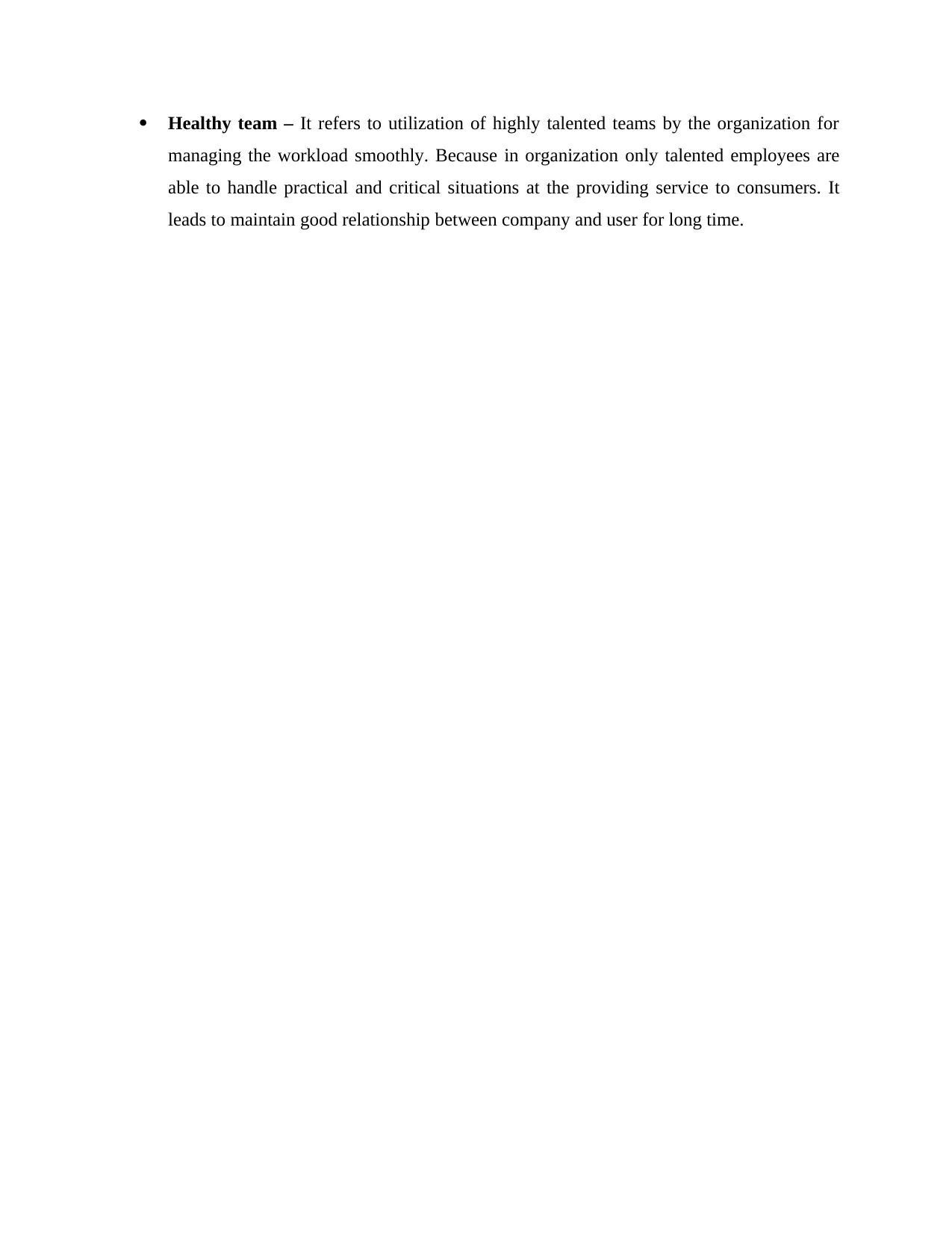
Healthy team – It refers to utilization of highly talented teams by the organization for
managing the workload smoothly. Because in organization only talented employees are
able to handle practical and critical situations at the providing service to consumers. It
leads to maintain good relationship between company and user for long time.
managing the workload smoothly. Because in organization only talented employees are
able to handle practical and critical situations at the providing service to consumers. It
leads to maintain good relationship between company and user for long time.
Paraphrase This Document
Need a fresh take? Get an instant paraphrase of this document with our AI Paraphraser
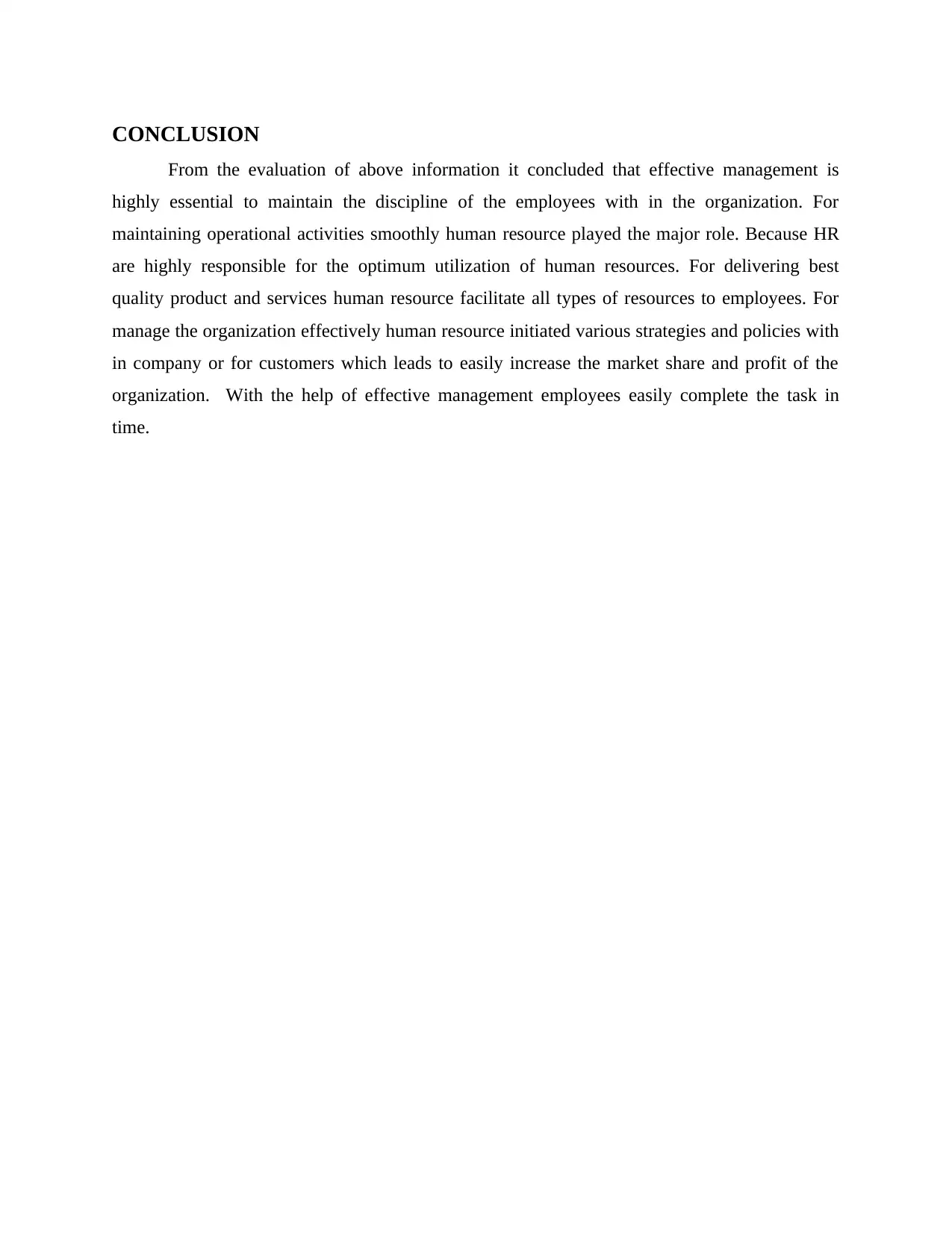
CONCLUSION
From the evaluation of above information it concluded that effective management is
highly essential to maintain the discipline of the employees with in the organization. For
maintaining operational activities smoothly human resource played the major role. Because HR
are highly responsible for the optimum utilization of human resources. For delivering best
quality product and services human resource facilitate all types of resources to employees. For
manage the organization effectively human resource initiated various strategies and policies with
in company or for customers which leads to easily increase the market share and profit of the
organization. With the help of effective management employees easily complete the task in
time.
From the evaluation of above information it concluded that effective management is
highly essential to maintain the discipline of the employees with in the organization. For
maintaining operational activities smoothly human resource played the major role. Because HR
are highly responsible for the optimum utilization of human resources. For delivering best
quality product and services human resource facilitate all types of resources to employees. For
manage the organization effectively human resource initiated various strategies and policies with
in company or for customers which leads to easily increase the market share and profit of the
organization. With the help of effective management employees easily complete the task in
time.
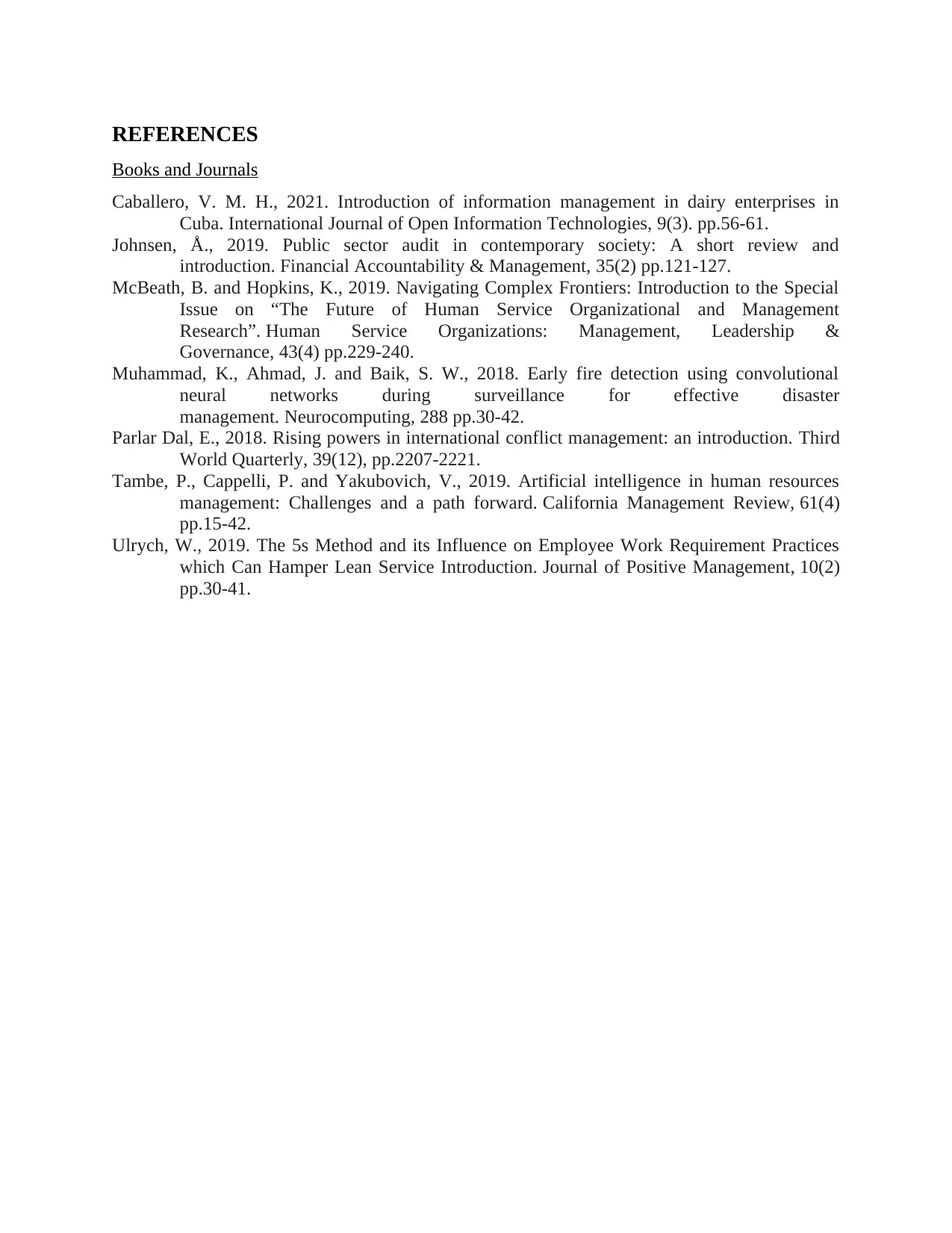
REFERENCES
Books and Journals
Caballero, V. M. H., 2021. Introduction of information management in dairy enterprises in
Cuba. International Journal of Open Information Technologies, 9(3). pp.56-61.
Johnsen, Å., 2019. Public sector audit in contemporary society: A short review and
introduction. Financial Accountability & Management, 35(2) pp.121-127.
McBeath, B. and Hopkins, K., 2019. Navigating Complex Frontiers: Introduction to the Special
Issue on “The Future of Human Service Organizational and Management
Research”. Human Service Organizations: Management, Leadership &
Governance, 43(4) pp.229-240.
Muhammad, K., Ahmad, J. and Baik, S. W., 2018. Early fire detection using convolutional
neural networks during surveillance for effective disaster
management. Neurocomputing, 288 pp.30-42.
Parlar Dal, E., 2018. Rising powers in international conflict management: an introduction. Third
World Quarterly, 39(12), pp.2207-2221.
Tambe, P., Cappelli, P. and Yakubovich, V., 2019. Artificial intelligence in human resources
management: Challenges and a path forward. California Management Review, 61(4)
pp.15-42.
Ulrych, W., 2019. The 5s Method and its Influence on Employee Work Requirement Practices
which Can Hamper Lean Service Introduction. Journal of Positive Management, 10(2)
pp.30-41.
Books and Journals
Caballero, V. M. H., 2021. Introduction of information management in dairy enterprises in
Cuba. International Journal of Open Information Technologies, 9(3). pp.56-61.
Johnsen, Å., 2019. Public sector audit in contemporary society: A short review and
introduction. Financial Accountability & Management, 35(2) pp.121-127.
McBeath, B. and Hopkins, K., 2019. Navigating Complex Frontiers: Introduction to the Special
Issue on “The Future of Human Service Organizational and Management
Research”. Human Service Organizations: Management, Leadership &
Governance, 43(4) pp.229-240.
Muhammad, K., Ahmad, J. and Baik, S. W., 2018. Early fire detection using convolutional
neural networks during surveillance for effective disaster
management. Neurocomputing, 288 pp.30-42.
Parlar Dal, E., 2018. Rising powers in international conflict management: an introduction. Third
World Quarterly, 39(12), pp.2207-2221.
Tambe, P., Cappelli, P. and Yakubovich, V., 2019. Artificial intelligence in human resources
management: Challenges and a path forward. California Management Review, 61(4)
pp.15-42.
Ulrych, W., 2019. The 5s Method and its Influence on Employee Work Requirement Practices
which Can Hamper Lean Service Introduction. Journal of Positive Management, 10(2)
pp.30-41.
⊘ This is a preview!⊘
Do you want full access?
Subscribe today to unlock all pages.

Trusted by 1+ million students worldwide

Paraphrase This Document
Need a fresh take? Get an instant paraphrase of this document with our AI Paraphraser

1 out of 11
Related Documents
Your All-in-One AI-Powered Toolkit for Academic Success.
+13062052269
info@desklib.com
Available 24*7 on WhatsApp / Email
![[object Object]](/_next/static/media/star-bottom.7253800d.svg)
Unlock your academic potential
Copyright © 2020–2025 A2Z Services. All Rights Reserved. Developed and managed by ZUCOL.



